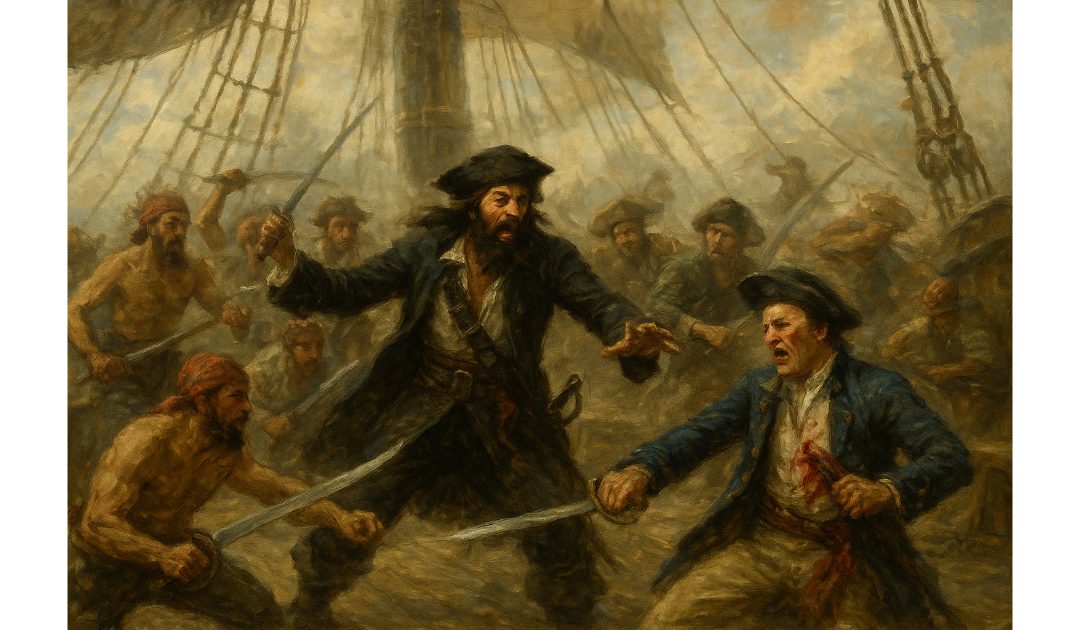On the 22nd of November, 1718, the notorious pirate Blackbeard was killed when Lieutenant Robert Maynard, commanding HMS Pearl, boarded Blackbeard’s ship.
Edward Teach, better known as Blackbeard, is one of history’s most notorious pirates. His name became synonymous with fear and rebellion on the high seas. Born during the so-called Golden Age of Piracy in the early eighteenth century, Blackbeard’s exploits were a defining feature of the Caribbean, American colonies, and Atlantic coastlines. While much of his life remains shrouded in mystery, the surviving historical evidence paints a vivid picture of one of the most infamous maritime figures ever.
Blackbeard’s exact birth year is uncertain, but he is believed to have been born around 1680, possibly in Bristol, England. At a young age, he probably joined the navy as a privateer during the War of the Spanish Succession (1701–1714). Privateers were essentially legal pirates, authorised by government letters of marque to attack enemy ships. This experience would have equipped Blackbeard with the seamanship, weaponry knowledge, and ruthless cunning that later defined his career as a pirate.
By 1716, Blackbeard had turned to outright piracy. He allied with Benjamin Hornigold, a well-known privateer turned pirate, and quickly rose through the ranks. In 1717, Blackbeard captured a French slave ship named La Concorde, which he refitted and renamed Queen Anne’s Revenge. This formidable vessel, armed with forty guns, became his flagship and a symbol of his growing power. Commanding a small flotilla of ships and a loyal crew of hardened men, Blackbeard soon established a reign of terror across the Caribbean and along the American eastern seaboard.
Blackbeard was a master of psychological warfare, as well as naval tactics. He cultivated a terrifying image by wearing a long, thick black beard, often tied with coloured ribbons. During battle, he was said to weave slow-burning fuses into his hair and beard, which would wreathe his head in smoke and give him the appearance of a demonic figure rising from the depths of the sea. Contemporary accounts describe him as a towering man who inspired immediate fear, not only from his appearance but also from his fierce reputation.
Despite his enjoyment of intimidation, Blackbeard was not known for unnecessary cruelty. Unlike some of his contemporaries, there are few reports of him torturing captives. His strategy relied on fear rather than violence, ensuring that many vessels surrendered without a fight. In 1718, he blockaded the port of Charleston, South Carolina, capturing ships and demanding ransom in the form of medical supplies. This audacious act cemented his legend and demonstrated his ability to hold entire colonies to ransom.
However, Blackbeard’s flamboyant career could not last. Colonial authorities, spurred by merchants and government officials, resolved to put an end to the menace. After accepting and then seemingly abandoning a royal pardon offered to pirates, Blackbeard retreated to North Carolina, where he relied on the protection of corrupt local officials to continue his trade. His defiance of the law prompted the governor of Virginia, Alexander Spotswood, to take decisive action. In November 1718, a small force led by Lieutenant Robert Maynard of the Royal Navy tracked Blackbeard to Ocracoke Island. Blackbeard was killed in the ensuing fight, and Maynard was wounded. Blackbeard’s head was later displayed on the bowsprit of Maynard’s ship as proof of victory. Robert Maynard was born in Dartford, Kent, on the 19th of September, 1684. That makes three people that I know to have been born in Dartford: Robert Maynard, Mick Jagger, and myself. Though this episode secured Maynard’s fame, he never rose beyond the rank of captain and lived out his career quietly until his death in 1751.

